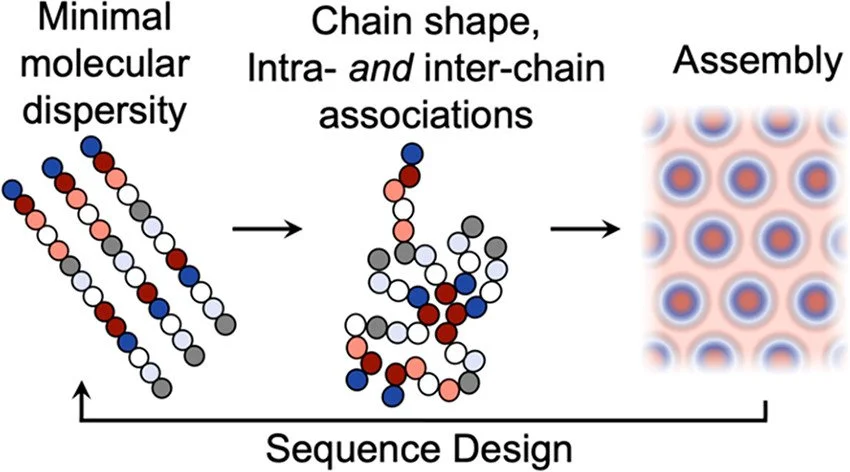Bio-inspired Materials (peptoids)
Biological polypeptides are complex copolymers that derive their phenomenal properties from precisely controlled sequences and compositions of the constituent amino acid monomers, which in turn lead to precisely controlled chain shapes and self-assembled structures. While these materials can be synthetically produced, they are made in notoriously low yield and small quantities.
Polypeptoids are a class of non-natural biomimetic oligomers based on an N-substituted glycine backbone that combine many of the advantageous properties of bulk polymers with those of synthetically produced proteins. As opposed to polypeptides, polypeptoids have an achiral backbone devoid of hydrogen bond donors, which makes them readily processable while still being able to form secondary structures such as helices. Furthermore, they are protease resistant, chemically and thermally stable, and can be synthesized at larger scales with more diverse functionalities.
Understanding Sequence-Structure Relationships
Our group has created self-assembling polypeptoid systems which have hierarchical levels of control reminiscent of biological molecules. We are currently studying how sequence patterning of different side chains can be leveraged to control single chain shape and assembly into larger mesostructures. Specific patterning of hydrophobic interactions can be used to tune the chain shape in solution, bringing the chain ends together and creating deviations from classic polymer theories. Crystallization of helical, dual-substituted polypeptoids (sort of a peptoid/peptide hybrid chemistry) creates uniform polypeptoid nanosheets, providing a new route to synthesizing polypeptoid nanostructures.
Understanding polymer/water interfaces
In addition to guiding self-assembly, we use polypeptoid sequence to control the behavior of nearby water molecules. This work is inspired by proteins whose selective interactions with solutes are mediated by variations in the structure and dynamics of hydration water. In particular, we have shown that variation in polymer density can be used to access a gradient of water diffusivities within polymeric assemblies. We have also demonstrated the ability of chemical patterning to fine-tune local water behavior.
Designing marine anti-fouling coatings
Accumulation of algae and barnacles on ship hulls decreases fuel efficiency and promotes invasive species introduction. Antifouling coatings are commonly applied to ships in an attempt to prevent adhesion of these species. Early antifouling coatings utilized biocidal organometallic compounds, which are highly toxic to the marine environment. Because of this, environmentally benign alternatives to these coatings have been widely investigated with a number of promising new strategies. Use of highly hydrophilic and zwitterionic polymers inhibit the adsorption of fouling organisms due to the presence of a water hydration layer, effectively hiding the ship surface. In contrast, highly hydrophobic coatings from which foulants can easily be removed by shear forces (so-called fouling release coatings) are also used. Furthermore, three dimensionally patterned surfaces and surfaces with mixed functionalities have been proven to discourage attachment. This diversity of strategies results in many vastly different polymer chemistries which are difficult to directly compare, presenting a fundamental problem in gaining understanding and developing new coatings.
Polypeptoids provide a unique platform for systematically studying and directly comparing new antifouling chemistries. New side functionalities (zwitterions, acid/base buffers, redox active) can be easily incorporated into peptoid chains as side chains with the same backbone chemistry. Further, we can combine multiple antifouling functionalities and control the precise location along the chain thanks to the sequence specificity of the submonomer synthetic protocol. In this way we can design a coating with optimum performance, while at the same time exploring the chemical and physical properties of these new materials.


